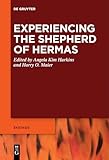Experiencing the Shepherd of Hermas / ed. by Angela Kim Harkins, Harry O. Maier.
Material type: TextSeries: Ekstasis: Religious Experience from Antiquity to the Middle Ages ; 10Publisher: Berlin ; Boston : De Gruyter, [2022]Copyright date: ©2022Description: 1 online resource (XII, 275 p.)Content type:
TextSeries: Ekstasis: Religious Experience from Antiquity to the Middle Ages ; 10Publisher: Berlin ; Boston : De Gruyter, [2022]Copyright date: ©2022Description: 1 online resource (XII, 275 p.)Content type: - 9783110779547
- 9783110780758
- 9783110780741
- 229.93
- BS2900.H5
- online - DeGruyter
- Issued also in print.
| Item type | Current library | Call number | URL | Status | Notes | Barcode | |
|---|---|---|---|---|---|---|---|
 eBook
eBook
|
Biblioteca "Angelicum" Pont. Univ. S.Tommaso d'Aquino Nuvola online | online - DeGruyter (Browse shelf(Opens below)) | Online access | Not for loan (Accesso limitato) | Accesso per gli utenti autorizzati / Access for authorized users | (dgr)9783110780741 |
Frontmatter -- Acknowledgements -- Abbreviations -- Foreword -- Table of Contents -- Introduction -- I The Shepherd, the Self, and Subjectivity -- Negotiating the Experience of Possession in Hermas’s Shepherd -- A True Prophet as a Mouthpiece of the Spirit? Cultivating Virtue and Control -- Gender, Volubility, and Transformation in the Shepherd of Hermas -- The Affect and Happy Objects of the Shepherd of Hermas -- II Visions and Experiences of the Divine -- Psychotropic Elements in Hermas’s First Two Visions: Between Experience and Culture -- Entering the Narrative World of Hermas’s Visions -- Experience through Narrative in the Shepherd of Hermas -- Shepherd of Hermas Vision 5 and the Christian Experience of Pagan Epiphany -- God’s Multiple Forms: Divine Fluidity in the Shepherd of Hermas -- III Experiencing the Shepherd as Text -- The Former Slave Hermas, Lady Church and ‘the Book’ -- Authority, Fragmentation, Dilution: Experiencing an Apocalyptic Text in Late Antiquity -- Bibliography -- List of Contributors -- Index of Subjects -- Ancient Text Index
restricted access online access with authorization star
http://purl.org/coar/access_right/c_16ec
The Shepherd of Hermas is one of the oldest and most well-attested Christian works. Its popularity arguably exceeded that of the canonical Gospels. Many early Christian thinkers regarded the Shepherd as authoritative and cited it in their own writings, even though its status as Scripture was controversial. The far-reaching influence of the Shepherd during the first few centuries is attested in part by the many languages in which it was copied: Latin, Ethiopic, Coptic, Middle Persian, and Georgian. The early dating and wide dissemination of the Shepherd of Hermas offers us access to a period when canonical boundaries were elastic. This volume treats religious experience in the Shepherd, a topic that has received little scholarly attention. It complements a growing body of literature that explores the text from social-historical perspectives. Leading scholars approach it from a variety of interdisciplinary perspectives, including critical literary theory, anthropology, cognitive science, affect theory, gender studies, intersectionality, and text reception. In doing so, they pose fresh questions to one of the most widely read texts in the early church, offering new insights to scholars and students alike.
Issued also in print.
Mode of access: Internet via World Wide Web.
In English.
Description based on online resource; title from PDF title page (publisher's Web site, viewed 02. Mai 2023)


